Analysis of Legal Liabilities and Business Structure Recommendations
VerifiedAdded on 2020/04/29
|10
|3276
|76
AI Summary
The provided text outlines three distinct legal scenarios requiring in-depth analysis. The first scenario examines liability issues within a partnership concerning misrepresentation and negligent advice. It explores how partners may be held accountable under tort law despite the absence of specific statutory provisions, emphasizing vicarious liability principles. In contrast, the second scenario suggests transitioning from a partnership to a corporate structure to mitigate personal liabilities and facilitate capital raising. The final scenario delves into corporate vicarious liability, particularly focusing on unauthorized actions by directors and the implications for corporate responsibility under the Corporations Act. Collectively, these scenarios underscore the importance of legal diligence in business operations and strategic decision-making regarding organizational structures.
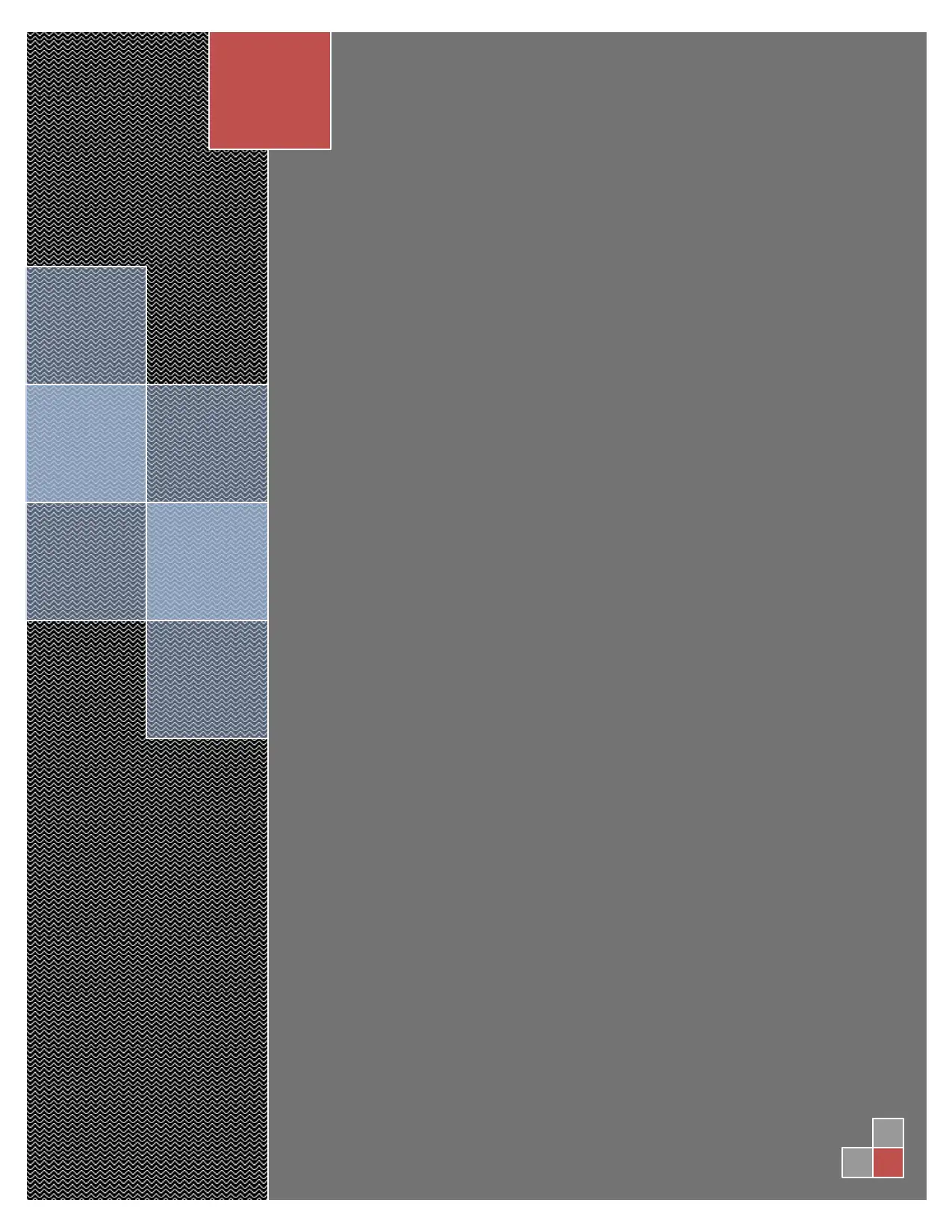
Paraphrase This Document
Need a fresh take? Get an instant paraphrase of this document with our AI Paraphraser
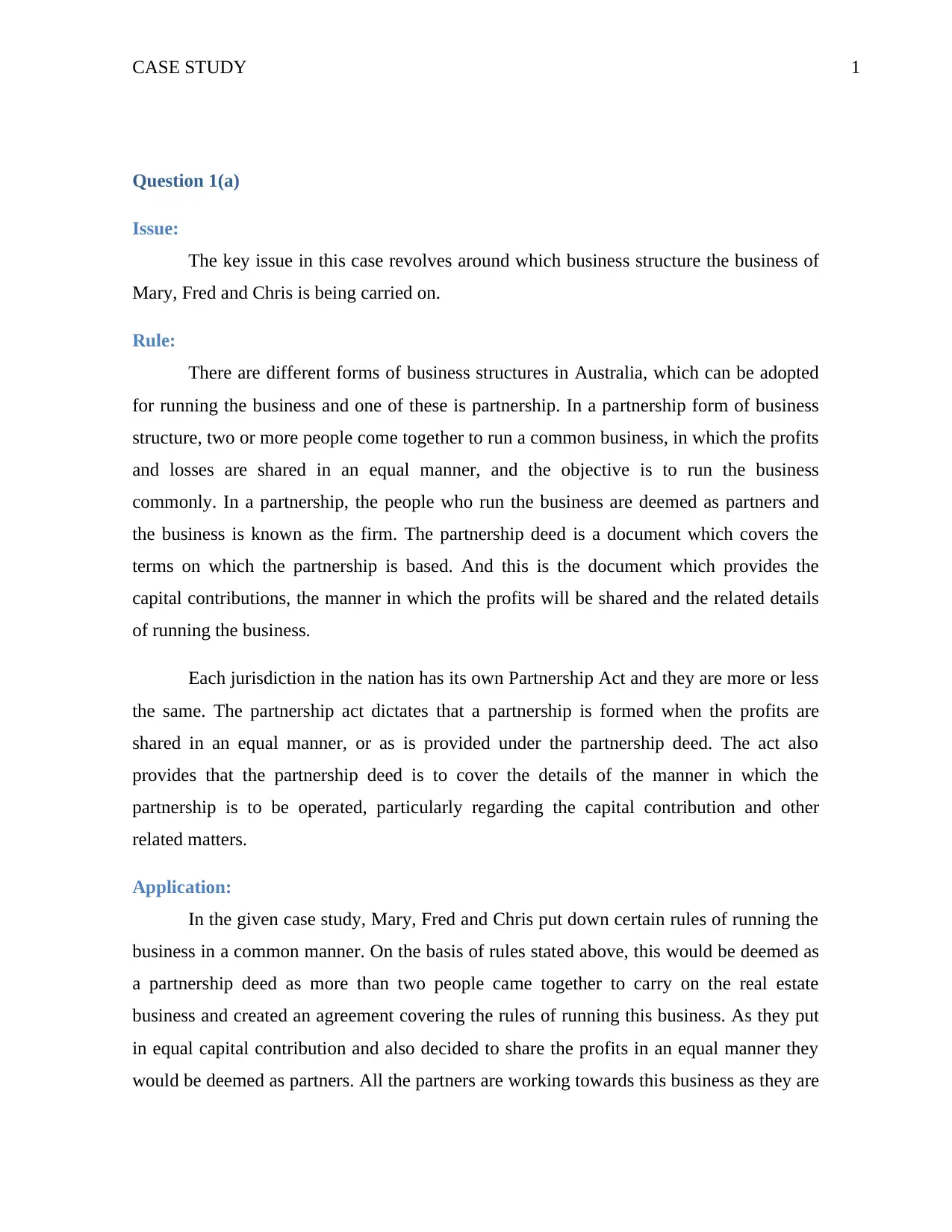
CASE STUDY 1
Question 1(a)
Issue:
The key issue in this case revolves around which business structure the business of
Mary, Fred and Chris is being carried on.
Rule:
There are different forms of business structures in Australia, which can be adopted
for running the business and one of these is partnership. In a partnership form of business
structure, two or more people come together to run a common business, in which the profits
and losses are shared in an equal manner, and the objective is to run the business
commonly. In a partnership, the people who run the business are deemed as partners and
the business is known as the firm. The partnership deed is a document which covers the
terms on which the partnership is based. And this is the document which provides the
capital contributions, the manner in which the profits will be shared and the related details
of running the business.
Each jurisdiction in the nation has its own Partnership Act and they are more or less
the same. The partnership act dictates that a partnership is formed when the profits are
shared in an equal manner, or as is provided under the partnership deed. The act also
provides that the partnership deed is to cover the details of the manner in which the
partnership is to be operated, particularly regarding the capital contribution and other
related matters.
Application:
In the given case study, Mary, Fred and Chris put down certain rules of running the
business in a common manner. On the basis of rules stated above, this would be deemed as
a partnership deed as more than two people came together to carry on the real estate
business and created an agreement covering the rules of running this business. As they put
in equal capital contribution and also decided to share the profits in an equal manner they
would be deemed as partners. All the partners are working towards this business as they are
Question 1(a)
Issue:
The key issue in this case revolves around which business structure the business of
Mary, Fred and Chris is being carried on.
Rule:
There are different forms of business structures in Australia, which can be adopted
for running the business and one of these is partnership. In a partnership form of business
structure, two or more people come together to run a common business, in which the profits
and losses are shared in an equal manner, and the objective is to run the business
commonly. In a partnership, the people who run the business are deemed as partners and
the business is known as the firm. The partnership deed is a document which covers the
terms on which the partnership is based. And this is the document which provides the
capital contributions, the manner in which the profits will be shared and the related details
of running the business.
Each jurisdiction in the nation has its own Partnership Act and they are more or less
the same. The partnership act dictates that a partnership is formed when the profits are
shared in an equal manner, or as is provided under the partnership deed. The act also
provides that the partnership deed is to cover the details of the manner in which the
partnership is to be operated, particularly regarding the capital contribution and other
related matters.
Application:
In the given case study, Mary, Fred and Chris put down certain rules of running the
business in a common manner. On the basis of rules stated above, this would be deemed as
a partnership deed as more than two people came together to carry on the real estate
business and created an agreement covering the rules of running this business. As they put
in equal capital contribution and also decided to share the profits in an equal manner they
would be deemed as partners. All the partners are working towards this business as they are
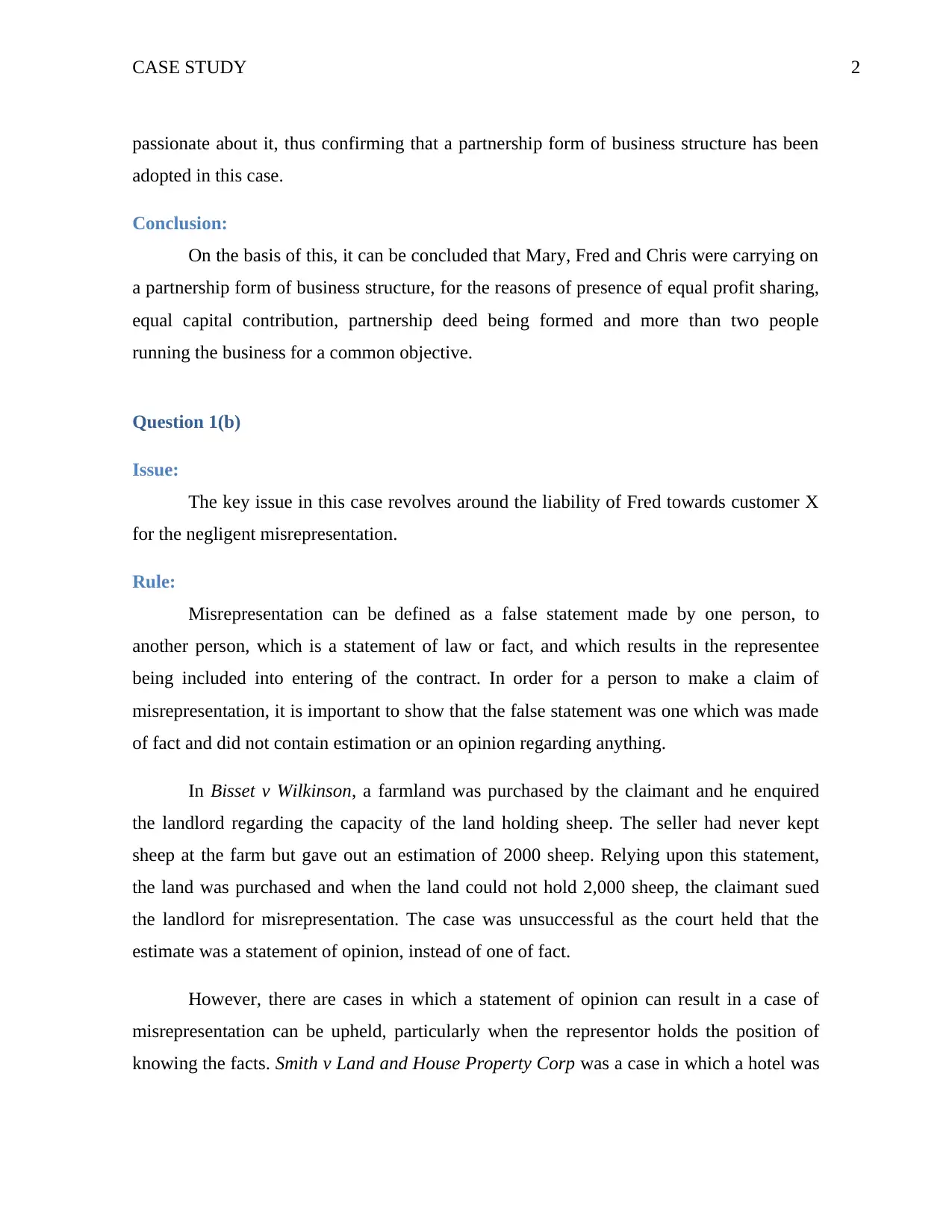
CASE STUDY 2
passionate about it, thus confirming that a partnership form of business structure has been
adopted in this case.
Conclusion:
On the basis of this, it can be concluded that Mary, Fred and Chris were carrying on
a partnership form of business structure, for the reasons of presence of equal profit sharing,
equal capital contribution, partnership deed being formed and more than two people
running the business for a common objective.
Question 1(b)
Issue:
The key issue in this case revolves around the liability of Fred towards customer X
for the negligent misrepresentation.
Rule:
Misrepresentation can be defined as a false statement made by one person, to
another person, which is a statement of law or fact, and which results in the representee
being included into entering of the contract. In order for a person to make a claim of
misrepresentation, it is important to show that the false statement was one which was made
of fact and did not contain estimation or an opinion regarding anything.
In Bisset v Wilkinson, a farmland was purchased by the claimant and he enquired
the landlord regarding the capacity of the land holding sheep. The seller had never kept
sheep at the farm but gave out an estimation of 2000 sheep. Relying upon this statement,
the land was purchased and when the land could not hold 2,000 sheep, the claimant sued
the landlord for misrepresentation. The case was unsuccessful as the court held that the
estimate was a statement of opinion, instead of one of fact.
However, there are cases in which a statement of opinion can result in a case of
misrepresentation can be upheld, particularly when the representor holds the position of
knowing the facts. Smith v Land and House Property Corp was a case in which a hotel was
passionate about it, thus confirming that a partnership form of business structure has been
adopted in this case.
Conclusion:
On the basis of this, it can be concluded that Mary, Fred and Chris were carrying on
a partnership form of business structure, for the reasons of presence of equal profit sharing,
equal capital contribution, partnership deed being formed and more than two people
running the business for a common objective.
Question 1(b)
Issue:
The key issue in this case revolves around the liability of Fred towards customer X
for the negligent misrepresentation.
Rule:
Misrepresentation can be defined as a false statement made by one person, to
another person, which is a statement of law or fact, and which results in the representee
being included into entering of the contract. In order for a person to make a claim of
misrepresentation, it is important to show that the false statement was one which was made
of fact and did not contain estimation or an opinion regarding anything.
In Bisset v Wilkinson, a farmland was purchased by the claimant and he enquired
the landlord regarding the capacity of the land holding sheep. The seller had never kept
sheep at the farm but gave out an estimation of 2000 sheep. Relying upon this statement,
the land was purchased and when the land could not hold 2,000 sheep, the claimant sued
the landlord for misrepresentation. The case was unsuccessful as the court held that the
estimate was a statement of opinion, instead of one of fact.
However, there are cases in which a statement of opinion can result in a case of
misrepresentation can be upheld, particularly when the representor holds the position of
knowing the facts. Smith v Land and House Property Corp was a case in which a hotel was
⊘ This is a preview!⊘
Do you want full access?
Subscribe today to unlock all pages.

Trusted by 1+ million students worldwide
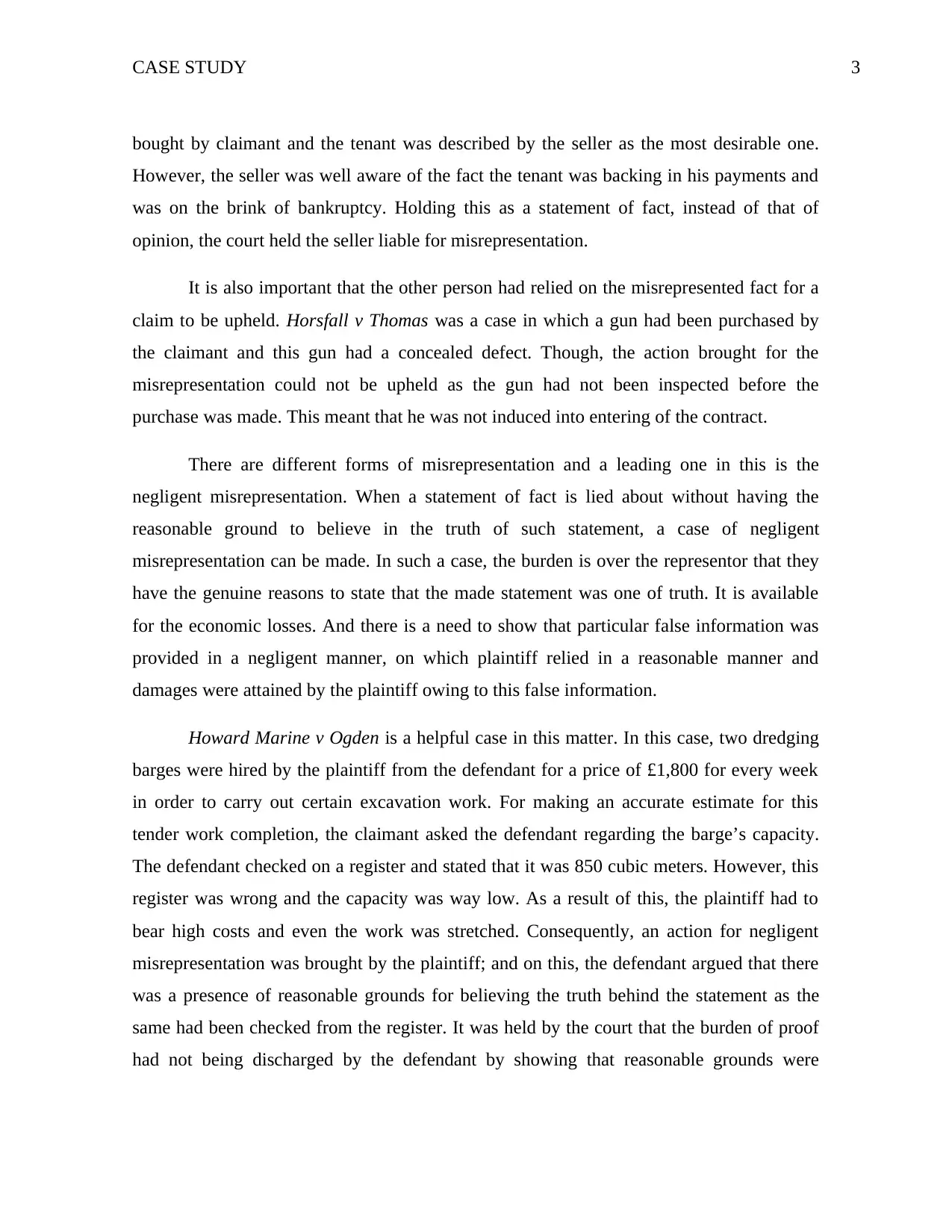
CASE STUDY 3
bought by claimant and the tenant was described by the seller as the most desirable one.
However, the seller was well aware of the fact the tenant was backing in his payments and
was on the brink of bankruptcy. Holding this as a statement of fact, instead of that of
opinion, the court held the seller liable for misrepresentation.
It is also important that the other person had relied on the misrepresented fact for a
claim to be upheld. Horsfall v Thomas was a case in which a gun had been purchased by
the claimant and this gun had a concealed defect. Though, the action brought for the
misrepresentation could not be upheld as the gun had not been inspected before the
purchase was made. This meant that he was not induced into entering of the contract.
There are different forms of misrepresentation and a leading one in this is the
negligent misrepresentation. When a statement of fact is lied about without having the
reasonable ground to believe in the truth of such statement, a case of negligent
misrepresentation can be made. In such a case, the burden is over the representor that they
have the genuine reasons to state that the made statement was one of truth. It is available
for the economic losses. And there is a need to show that particular false information was
provided in a negligent manner, on which plaintiff relied in a reasonable manner and
damages were attained by the plaintiff owing to this false information.
Howard Marine v Ogden is a helpful case in this matter. In this case, two dredging
barges were hired by the plaintiff from the defendant for a price of £1,800 for every week
in order to carry out certain excavation work. For making an accurate estimate for this
tender work completion, the claimant asked the defendant regarding the barge’s capacity.
The defendant checked on a register and stated that it was 850 cubic meters. However, this
register was wrong and the capacity was way low. As a result of this, the plaintiff had to
bear high costs and even the work was stretched. Consequently, an action for negligent
misrepresentation was brought by the plaintiff; and on this, the defendant argued that there
was a presence of reasonable grounds for believing the truth behind the statement as the
same had been checked from the register. It was held by the court that the burden of proof
had not being discharged by the defendant by showing that reasonable grounds were
bought by claimant and the tenant was described by the seller as the most desirable one.
However, the seller was well aware of the fact the tenant was backing in his payments and
was on the brink of bankruptcy. Holding this as a statement of fact, instead of that of
opinion, the court held the seller liable for misrepresentation.
It is also important that the other person had relied on the misrepresented fact for a
claim to be upheld. Horsfall v Thomas was a case in which a gun had been purchased by
the claimant and this gun had a concealed defect. Though, the action brought for the
misrepresentation could not be upheld as the gun had not been inspected before the
purchase was made. This meant that he was not induced into entering of the contract.
There are different forms of misrepresentation and a leading one in this is the
negligent misrepresentation. When a statement of fact is lied about without having the
reasonable ground to believe in the truth of such statement, a case of negligent
misrepresentation can be made. In such a case, the burden is over the representor that they
have the genuine reasons to state that the made statement was one of truth. It is available
for the economic losses. And there is a need to show that particular false information was
provided in a negligent manner, on which plaintiff relied in a reasonable manner and
damages were attained by the plaintiff owing to this false information.
Howard Marine v Ogden is a helpful case in this matter. In this case, two dredging
barges were hired by the plaintiff from the defendant for a price of £1,800 for every week
in order to carry out certain excavation work. For making an accurate estimate for this
tender work completion, the claimant asked the defendant regarding the barge’s capacity.
The defendant checked on a register and stated that it was 850 cubic meters. However, this
register was wrong and the capacity was way low. As a result of this, the plaintiff had to
bear high costs and even the work was stretched. Consequently, an action for negligent
misrepresentation was brought by the plaintiff; and on this, the defendant argued that there
was a presence of reasonable grounds for believing the truth behind the statement as the
same had been checked from the register. It was held by the court that the burden of proof
had not being discharged by the defendant by showing that reasonable grounds were
Paraphrase This Document
Need a fresh take? Get an instant paraphrase of this document with our AI Paraphraser
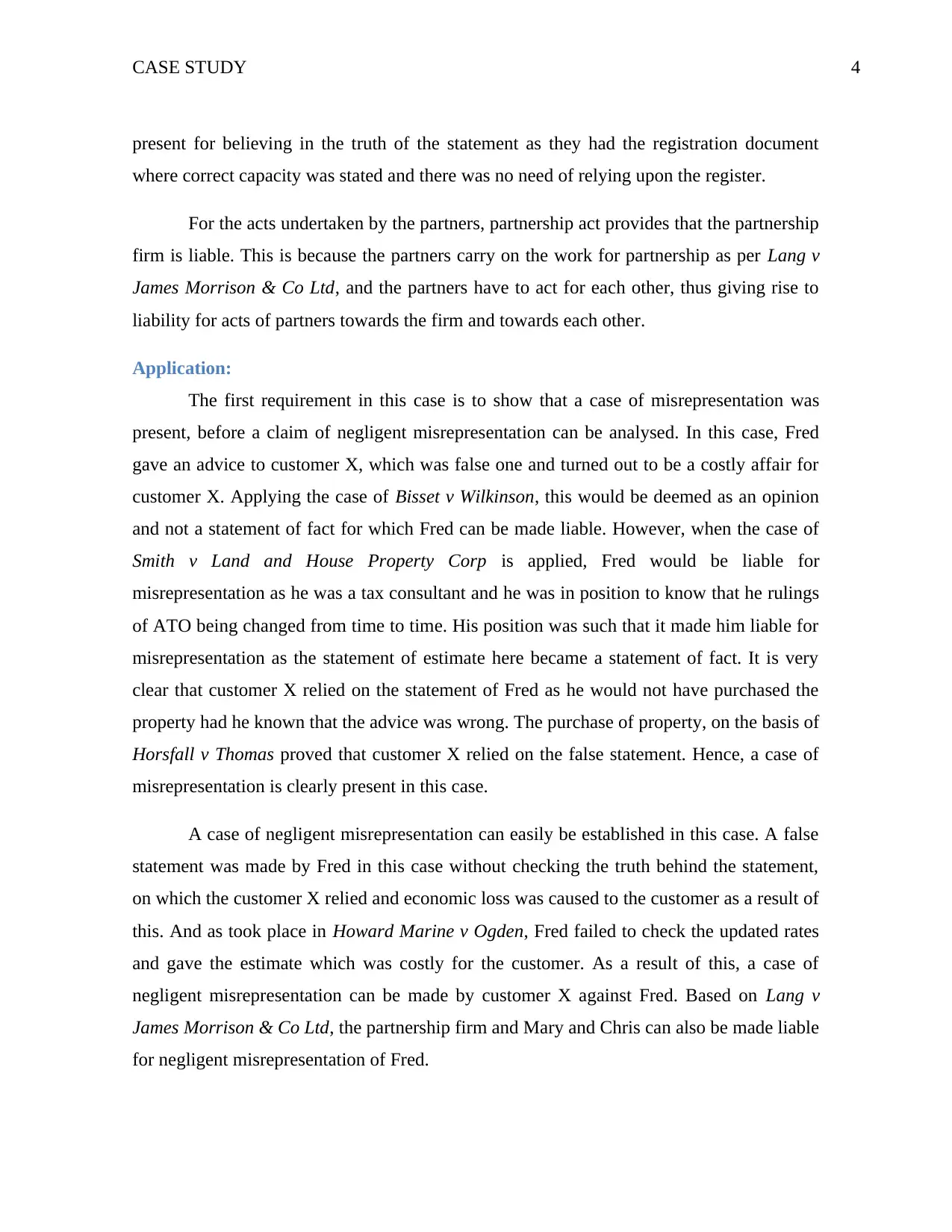
CASE STUDY 4
present for believing in the truth of the statement as they had the registration document
where correct capacity was stated and there was no need of relying upon the register.
For the acts undertaken by the partners, partnership act provides that the partnership
firm is liable. This is because the partners carry on the work for partnership as per Lang v
James Morrison & Co Ltd, and the partners have to act for each other, thus giving rise to
liability for acts of partners towards the firm and towards each other.
Application:
The first requirement in this case is to show that a case of misrepresentation was
present, before a claim of negligent misrepresentation can be analysed. In this case, Fred
gave an advice to customer X, which was false one and turned out to be a costly affair for
customer X. Applying the case of Bisset v Wilkinson, this would be deemed as an opinion
and not a statement of fact for which Fred can be made liable. However, when the case of
Smith v Land and House Property Corp is applied, Fred would be liable for
misrepresentation as he was a tax consultant and he was in position to know that he rulings
of ATO being changed from time to time. His position was such that it made him liable for
misrepresentation as the statement of estimate here became a statement of fact. It is very
clear that customer X relied on the statement of Fred as he would not have purchased the
property had he known that the advice was wrong. The purchase of property, on the basis of
Horsfall v Thomas proved that customer X relied on the false statement. Hence, a case of
misrepresentation is clearly present in this case.
A case of negligent misrepresentation can easily be established in this case. A false
statement was made by Fred in this case without checking the truth behind the statement,
on which the customer X relied and economic loss was caused to the customer as a result of
this. And as took place in Howard Marine v Ogden, Fred failed to check the updated rates
and gave the estimate which was costly for the customer. As a result of this, a case of
negligent misrepresentation can be made by customer X against Fred. Based on Lang v
James Morrison & Co Ltd, the partnership firm and Mary and Chris can also be made liable
for negligent misrepresentation of Fred.
present for believing in the truth of the statement as they had the registration document
where correct capacity was stated and there was no need of relying upon the register.
For the acts undertaken by the partners, partnership act provides that the partnership
firm is liable. This is because the partners carry on the work for partnership as per Lang v
James Morrison & Co Ltd, and the partners have to act for each other, thus giving rise to
liability for acts of partners towards the firm and towards each other.
Application:
The first requirement in this case is to show that a case of misrepresentation was
present, before a claim of negligent misrepresentation can be analysed. In this case, Fred
gave an advice to customer X, which was false one and turned out to be a costly affair for
customer X. Applying the case of Bisset v Wilkinson, this would be deemed as an opinion
and not a statement of fact for which Fred can be made liable. However, when the case of
Smith v Land and House Property Corp is applied, Fred would be liable for
misrepresentation as he was a tax consultant and he was in position to know that he rulings
of ATO being changed from time to time. His position was such that it made him liable for
misrepresentation as the statement of estimate here became a statement of fact. It is very
clear that customer X relied on the statement of Fred as he would not have purchased the
property had he known that the advice was wrong. The purchase of property, on the basis of
Horsfall v Thomas proved that customer X relied on the false statement. Hence, a case of
misrepresentation is clearly present in this case.
A case of negligent misrepresentation can easily be established in this case. A false
statement was made by Fred in this case without checking the truth behind the statement,
on which the customer X relied and economic loss was caused to the customer as a result of
this. And as took place in Howard Marine v Ogden, Fred failed to check the updated rates
and gave the estimate which was costly for the customer. As a result of this, a case of
negligent misrepresentation can be made by customer X against Fred. Based on Lang v
James Morrison & Co Ltd, the partnership firm and Mary and Chris can also be made liable
for negligent misrepresentation of Fred.
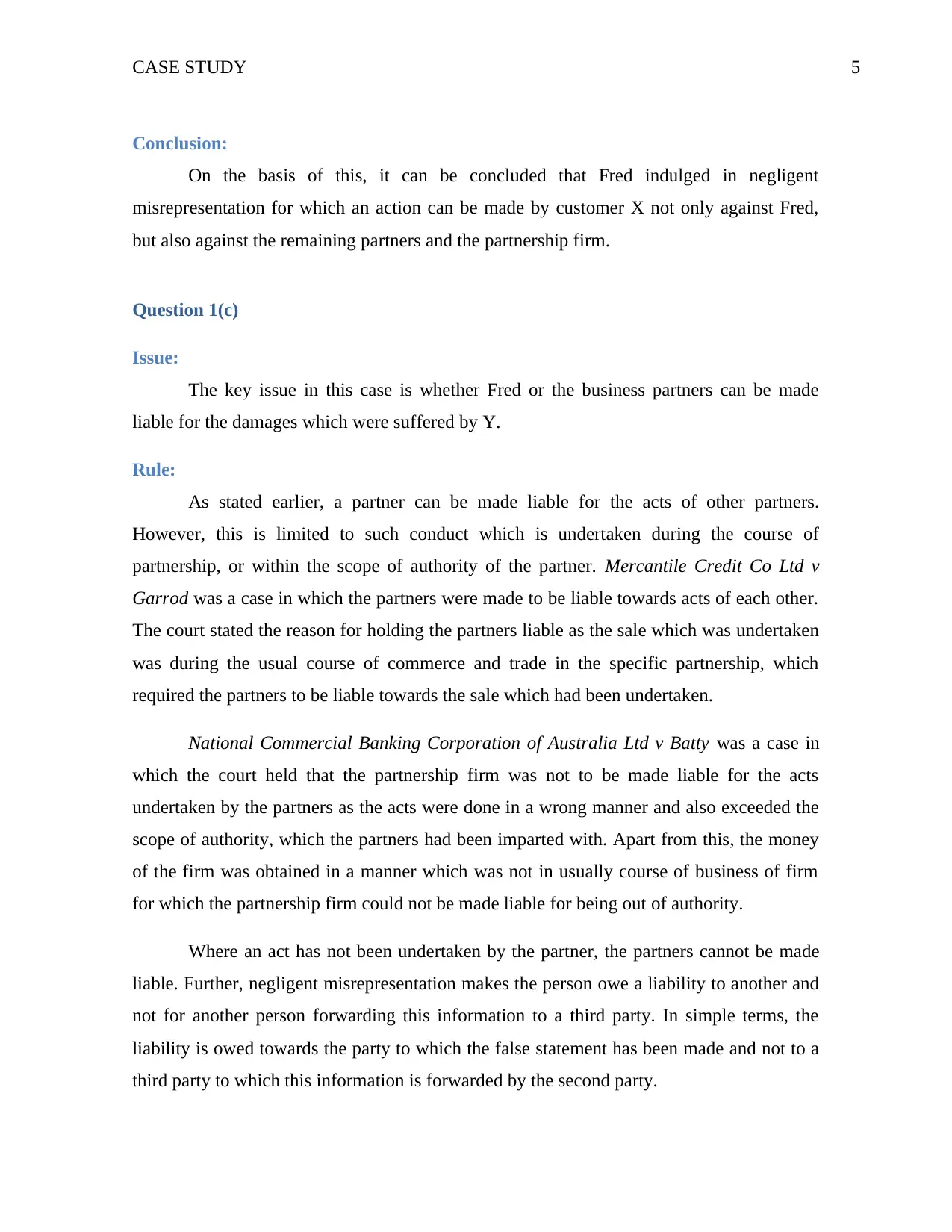
CASE STUDY 5
Conclusion:
On the basis of this, it can be concluded that Fred indulged in negligent
misrepresentation for which an action can be made by customer X not only against Fred,
but also against the remaining partners and the partnership firm.
Question 1(c)
Issue:
The key issue in this case is whether Fred or the business partners can be made
liable for the damages which were suffered by Y.
Rule:
As stated earlier, a partner can be made liable for the acts of other partners.
However, this is limited to such conduct which is undertaken during the course of
partnership, or within the scope of authority of the partner. Mercantile Credit Co Ltd v
Garrod was a case in which the partners were made to be liable towards acts of each other.
The court stated the reason for holding the partners liable as the sale which was undertaken
was during the usual course of commerce and trade in the specific partnership, which
required the partners to be liable towards the sale which had been undertaken.
National Commercial Banking Corporation of Australia Ltd v Batty was a case in
which the court held that the partnership firm was not to be made liable for the acts
undertaken by the partners as the acts were done in a wrong manner and also exceeded the
scope of authority, which the partners had been imparted with. Apart from this, the money
of the firm was obtained in a manner which was not in usually course of business of firm
for which the partnership firm could not be made liable for being out of authority.
Where an act has not been undertaken by the partner, the partners cannot be made
liable. Further, negligent misrepresentation makes the person owe a liability to another and
not for another person forwarding this information to a third party. In simple terms, the
liability is owed towards the party to which the false statement has been made and not to a
third party to which this information is forwarded by the second party.
Conclusion:
On the basis of this, it can be concluded that Fred indulged in negligent
misrepresentation for which an action can be made by customer X not only against Fred,
but also against the remaining partners and the partnership firm.
Question 1(c)
Issue:
The key issue in this case is whether Fred or the business partners can be made
liable for the damages which were suffered by Y.
Rule:
As stated earlier, a partner can be made liable for the acts of other partners.
However, this is limited to such conduct which is undertaken during the course of
partnership, or within the scope of authority of the partner. Mercantile Credit Co Ltd v
Garrod was a case in which the partners were made to be liable towards acts of each other.
The court stated the reason for holding the partners liable as the sale which was undertaken
was during the usual course of commerce and trade in the specific partnership, which
required the partners to be liable towards the sale which had been undertaken.
National Commercial Banking Corporation of Australia Ltd v Batty was a case in
which the court held that the partnership firm was not to be made liable for the acts
undertaken by the partners as the acts were done in a wrong manner and also exceeded the
scope of authority, which the partners had been imparted with. Apart from this, the money
of the firm was obtained in a manner which was not in usually course of business of firm
for which the partnership firm could not be made liable for being out of authority.
Where an act has not been undertaken by the partner, the partners cannot be made
liable. Further, negligent misrepresentation makes the person owe a liability to another and
not for another person forwarding this information to a third party. In simple terms, the
liability is owed towards the party to which the false statement has been made and not to a
third party to which this information is forwarded by the second party.
⊘ This is a preview!⊘
Do you want full access?
Subscribe today to unlock all pages.

Trusted by 1+ million students worldwide
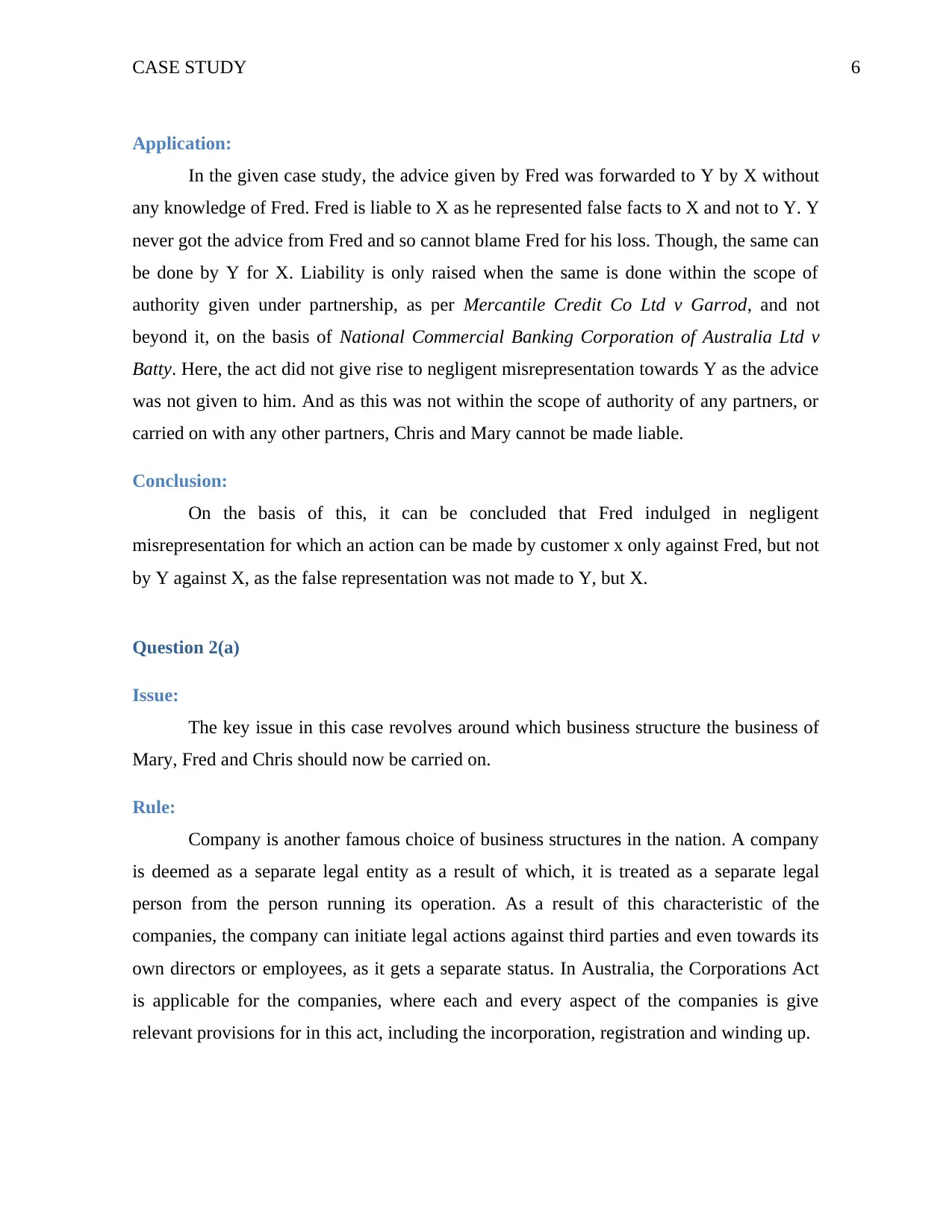
CASE STUDY 6
Application:
In the given case study, the advice given by Fred was forwarded to Y by X without
any knowledge of Fred. Fred is liable to X as he represented false facts to X and not to Y. Y
never got the advice from Fred and so cannot blame Fred for his loss. Though, the same can
be done by Y for X. Liability is only raised when the same is done within the scope of
authority given under partnership, as per Mercantile Credit Co Ltd v Garrod, and not
beyond it, on the basis of National Commercial Banking Corporation of Australia Ltd v
Batty. Here, the act did not give rise to negligent misrepresentation towards Y as the advice
was not given to him. And as this was not within the scope of authority of any partners, or
carried on with any other partners, Chris and Mary cannot be made liable.
Conclusion:
On the basis of this, it can be concluded that Fred indulged in negligent
misrepresentation for which an action can be made by customer x only against Fred, but not
by Y against X, as the false representation was not made to Y, but X.
Question 2(a)
Issue:
The key issue in this case revolves around which business structure the business of
Mary, Fred and Chris should now be carried on.
Rule:
Company is another famous choice of business structures in the nation. A company
is deemed as a separate legal entity as a result of which, it is treated as a separate legal
person from the person running its operation. As a result of this characteristic of the
companies, the company can initiate legal actions against third parties and even towards its
own directors or employees, as it gets a separate status. In Australia, the Corporations Act
is applicable for the companies, where each and every aspect of the companies is give
relevant provisions for in this act, including the incorporation, registration and winding up.
Application:
In the given case study, the advice given by Fred was forwarded to Y by X without
any knowledge of Fred. Fred is liable to X as he represented false facts to X and not to Y. Y
never got the advice from Fred and so cannot blame Fred for his loss. Though, the same can
be done by Y for X. Liability is only raised when the same is done within the scope of
authority given under partnership, as per Mercantile Credit Co Ltd v Garrod, and not
beyond it, on the basis of National Commercial Banking Corporation of Australia Ltd v
Batty. Here, the act did not give rise to negligent misrepresentation towards Y as the advice
was not given to him. And as this was not within the scope of authority of any partners, or
carried on with any other partners, Chris and Mary cannot be made liable.
Conclusion:
On the basis of this, it can be concluded that Fred indulged in negligent
misrepresentation for which an action can be made by customer x only against Fred, but not
by Y against X, as the false representation was not made to Y, but X.
Question 2(a)
Issue:
The key issue in this case revolves around which business structure the business of
Mary, Fred and Chris should now be carried on.
Rule:
Company is another famous choice of business structures in the nation. A company
is deemed as a separate legal entity as a result of which, it is treated as a separate legal
person from the person running its operation. As a result of this characteristic of the
companies, the company can initiate legal actions against third parties and even towards its
own directors or employees, as it gets a separate status. In Australia, the Corporations Act
is applicable for the companies, where each and every aspect of the companies is give
relevant provisions for in this act, including the incorporation, registration and winding up.
Paraphrase This Document
Need a fresh take? Get an instant paraphrase of this document with our AI Paraphraser
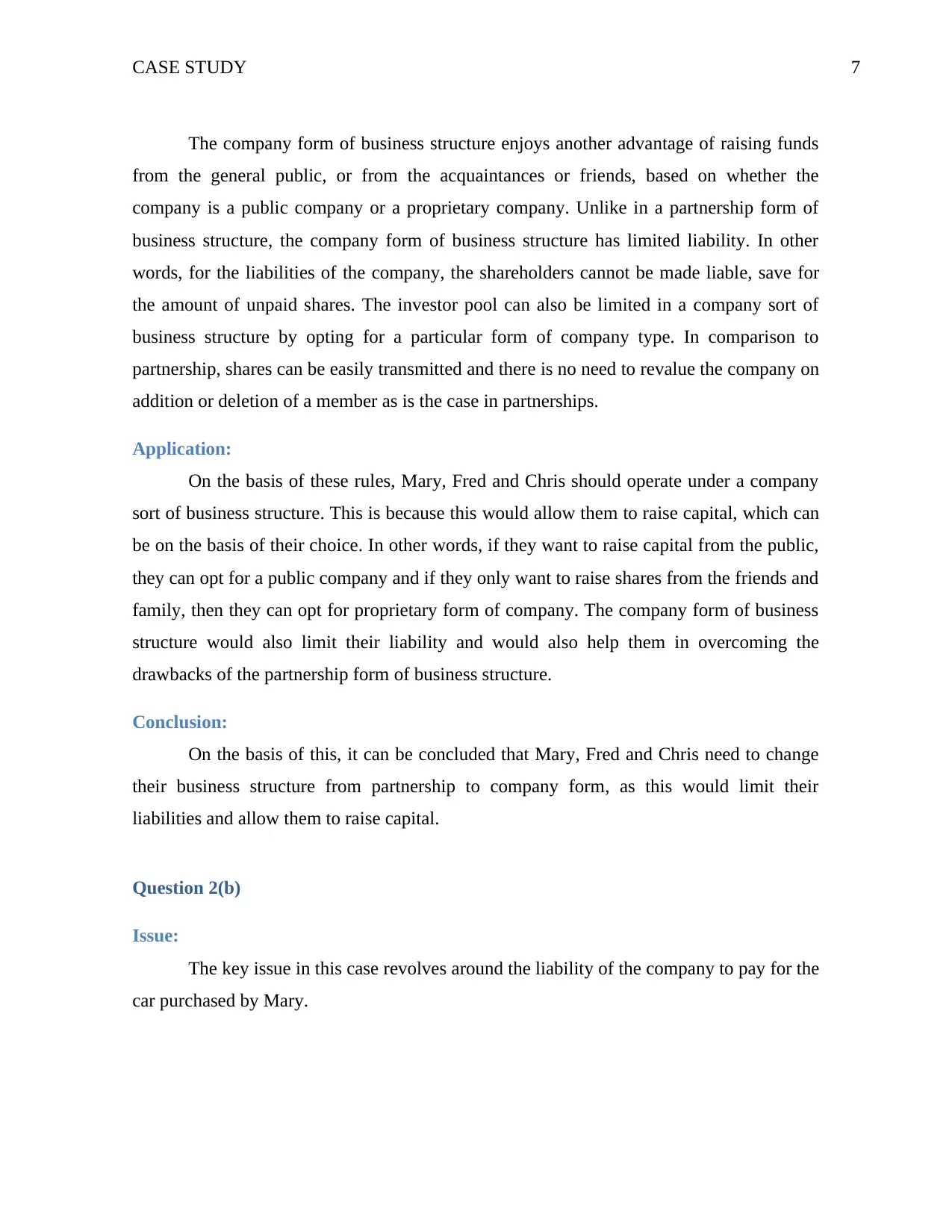
CASE STUDY 7
The company form of business structure enjoys another advantage of raising funds
from the general public, or from the acquaintances or friends, based on whether the
company is a public company or a proprietary company. Unlike in a partnership form of
business structure, the company form of business structure has limited liability. In other
words, for the liabilities of the company, the shareholders cannot be made liable, save for
the amount of unpaid shares. The investor pool can also be limited in a company sort of
business structure by opting for a particular form of company type. In comparison to
partnership, shares can be easily transmitted and there is no need to revalue the company on
addition or deletion of a member as is the case in partnerships.
Application:
On the basis of these rules, Mary, Fred and Chris should operate under a company
sort of business structure. This is because this would allow them to raise capital, which can
be on the basis of their choice. In other words, if they want to raise capital from the public,
they can opt for a public company and if they only want to raise shares from the friends and
family, then they can opt for proprietary form of company. The company form of business
structure would also limit their liability and would also help them in overcoming the
drawbacks of the partnership form of business structure.
Conclusion:
On the basis of this, it can be concluded that Mary, Fred and Chris need to change
their business structure from partnership to company form, as this would limit their
liabilities and allow them to raise capital.
Question 2(b)
Issue:
The key issue in this case revolves around the liability of the company to pay for the
car purchased by Mary.
The company form of business structure enjoys another advantage of raising funds
from the general public, or from the acquaintances or friends, based on whether the
company is a public company or a proprietary company. Unlike in a partnership form of
business structure, the company form of business structure has limited liability. In other
words, for the liabilities of the company, the shareholders cannot be made liable, save for
the amount of unpaid shares. The investor pool can also be limited in a company sort of
business structure by opting for a particular form of company type. In comparison to
partnership, shares can be easily transmitted and there is no need to revalue the company on
addition or deletion of a member as is the case in partnerships.
Application:
On the basis of these rules, Mary, Fred and Chris should operate under a company
sort of business structure. This is because this would allow them to raise capital, which can
be on the basis of their choice. In other words, if they want to raise capital from the public,
they can opt for a public company and if they only want to raise shares from the friends and
family, then they can opt for proprietary form of company. The company form of business
structure would also limit their liability and would also help them in overcoming the
drawbacks of the partnership form of business structure.
Conclusion:
On the basis of this, it can be concluded that Mary, Fred and Chris need to change
their business structure from partnership to company form, as this would limit their
liabilities and allow them to raise capital.
Question 2(b)
Issue:
The key issue in this case revolves around the liability of the company to pay for the
car purchased by Mary.
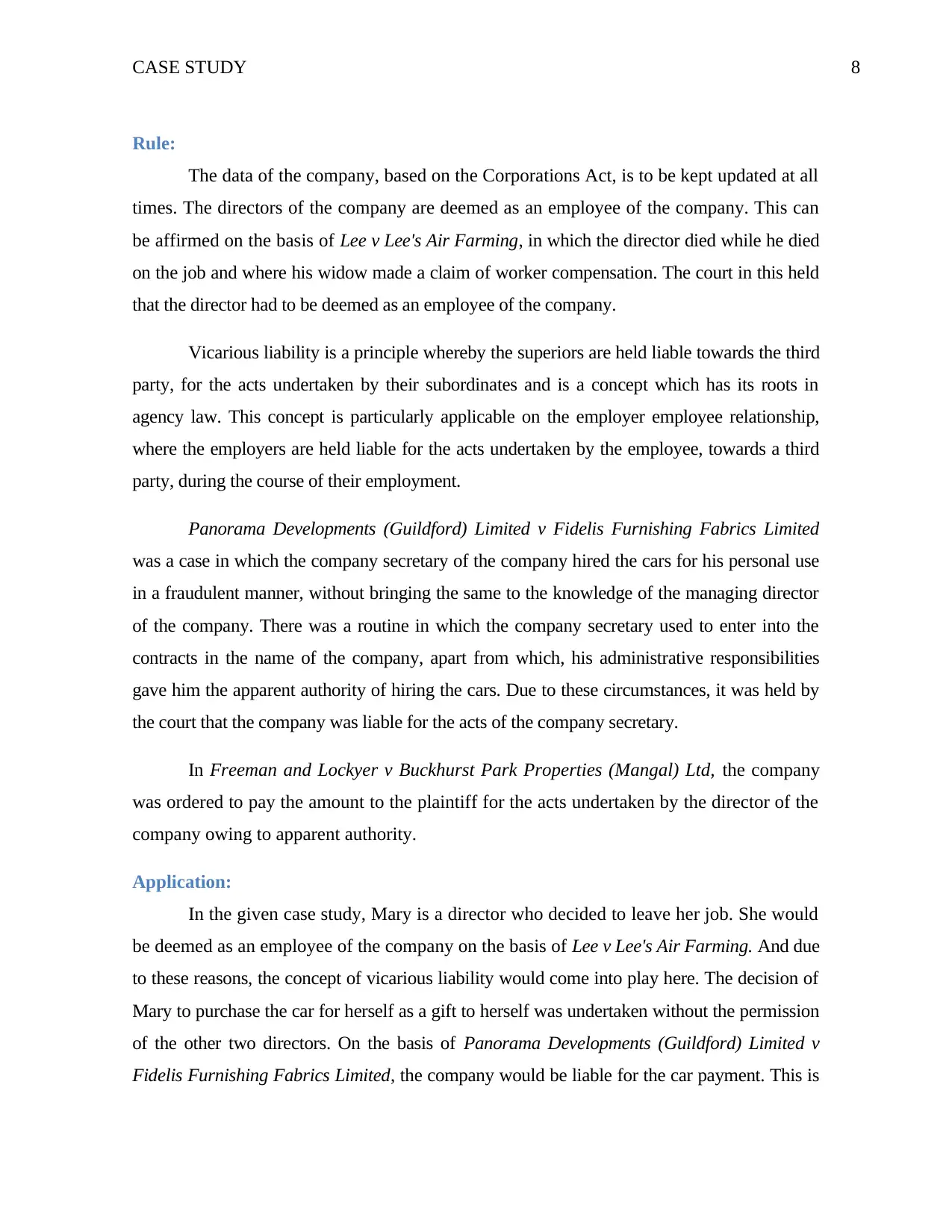
CASE STUDY 8
Rule:
The data of the company, based on the Corporations Act, is to be kept updated at all
times. The directors of the company are deemed as an employee of the company. This can
be affirmed on the basis of Lee v Lee's Air Farming, in which the director died while he died
on the job and where his widow made a claim of worker compensation. The court in this held
that the director had to be deemed as an employee of the company.
Vicarious liability is a principle whereby the superiors are held liable towards the third
party, for the acts undertaken by their subordinates and is a concept which has its roots in
agency law. This concept is particularly applicable on the employer employee relationship,
where the employers are held liable for the acts undertaken by the employee, towards a third
party, during the course of their employment.
Panorama Developments (Guildford) Limited v Fidelis Furnishing Fabrics Limited
was a case in which the company secretary of the company hired the cars for his personal use
in a fraudulent manner, without bringing the same to the knowledge of the managing director
of the company. There was a routine in which the company secretary used to enter into the
contracts in the name of the company, apart from which, his administrative responsibilities
gave him the apparent authority of hiring the cars. Due to these circumstances, it was held by
the court that the company was liable for the acts of the company secretary.
In Freeman and Lockyer v Buckhurst Park Properties (Mangal) Ltd, the company
was ordered to pay the amount to the plaintiff for the acts undertaken by the director of the
company owing to apparent authority.
Application:
In the given case study, Mary is a director who decided to leave her job. She would
be deemed as an employee of the company on the basis of Lee v Lee's Air Farming. And due
to these reasons, the concept of vicarious liability would come into play here. The decision of
Mary to purchase the car for herself as a gift to herself was undertaken without the permission
of the other two directors. On the basis of Panorama Developments (Guildford) Limited v
Fidelis Furnishing Fabrics Limited, the company would be liable for the car payment. This is
Rule:
The data of the company, based on the Corporations Act, is to be kept updated at all
times. The directors of the company are deemed as an employee of the company. This can
be affirmed on the basis of Lee v Lee's Air Farming, in which the director died while he died
on the job and where his widow made a claim of worker compensation. The court in this held
that the director had to be deemed as an employee of the company.
Vicarious liability is a principle whereby the superiors are held liable towards the third
party, for the acts undertaken by their subordinates and is a concept which has its roots in
agency law. This concept is particularly applicable on the employer employee relationship,
where the employers are held liable for the acts undertaken by the employee, towards a third
party, during the course of their employment.
Panorama Developments (Guildford) Limited v Fidelis Furnishing Fabrics Limited
was a case in which the company secretary of the company hired the cars for his personal use
in a fraudulent manner, without bringing the same to the knowledge of the managing director
of the company. There was a routine in which the company secretary used to enter into the
contracts in the name of the company, apart from which, his administrative responsibilities
gave him the apparent authority of hiring the cars. Due to these circumstances, it was held by
the court that the company was liable for the acts of the company secretary.
In Freeman and Lockyer v Buckhurst Park Properties (Mangal) Ltd, the company
was ordered to pay the amount to the plaintiff for the acts undertaken by the director of the
company owing to apparent authority.
Application:
In the given case study, Mary is a director who decided to leave her job. She would
be deemed as an employee of the company on the basis of Lee v Lee's Air Farming. And due
to these reasons, the concept of vicarious liability would come into play here. The decision of
Mary to purchase the car for herself as a gift to herself was undertaken without the permission
of the other two directors. On the basis of Panorama Developments (Guildford) Limited v
Fidelis Furnishing Fabrics Limited, the company would be liable for the car payment. This is
⊘ This is a preview!⊘
Do you want full access?
Subscribe today to unlock all pages.

Trusted by 1+ million students worldwide
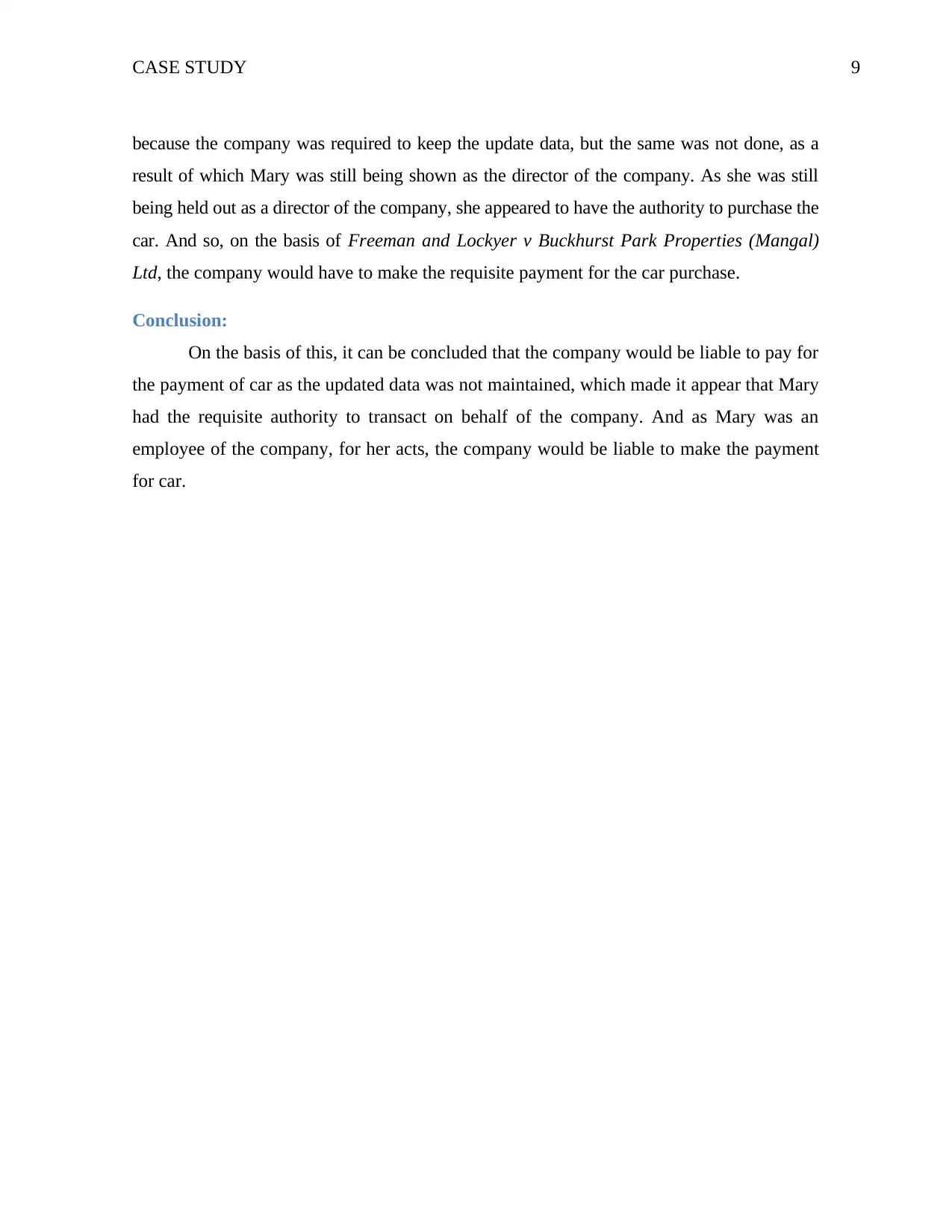
CASE STUDY 9
because the company was required to keep the update data, but the same was not done, as a
result of which Mary was still being shown as the director of the company. As she was still
being held out as a director of the company, she appeared to have the authority to purchase the
car. And so, on the basis of Freeman and Lockyer v Buckhurst Park Properties (Mangal)
Ltd, the company would have to make the requisite payment for the car purchase.
Conclusion:
On the basis of this, it can be concluded that the company would be liable to pay for
the payment of car as the updated data was not maintained, which made it appear that Mary
had the requisite authority to transact on behalf of the company. And as Mary was an
employee of the company, for her acts, the company would be liable to make the payment
for car.
because the company was required to keep the update data, but the same was not done, as a
result of which Mary was still being shown as the director of the company. As she was still
being held out as a director of the company, she appeared to have the authority to purchase the
car. And so, on the basis of Freeman and Lockyer v Buckhurst Park Properties (Mangal)
Ltd, the company would have to make the requisite payment for the car purchase.
Conclusion:
On the basis of this, it can be concluded that the company would be liable to pay for
the payment of car as the updated data was not maintained, which made it appear that Mary
had the requisite authority to transact on behalf of the company. And as Mary was an
employee of the company, for her acts, the company would be liable to make the payment
for car.
1 out of 10
Related Documents
Your All-in-One AI-Powered Toolkit for Academic Success.
+13062052269
info@desklib.com
Available 24*7 on WhatsApp / Email
![[object Object]](/_next/static/media/star-bottom.7253800d.svg)
Unlock your academic potential
Copyright © 2020–2025 A2Z Services. All Rights Reserved. Developed and managed by ZUCOL.





